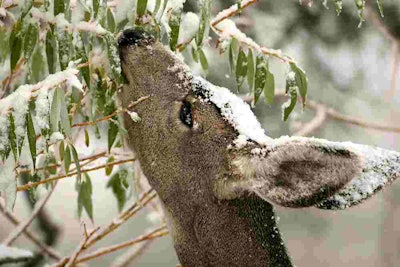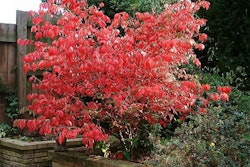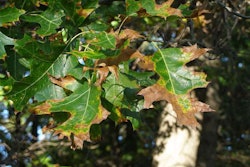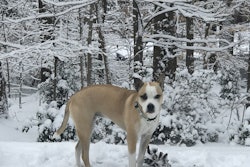
Depending on where your customers are located, deer may not be a top-tier threat. In areas where they are plentiful, customers know that the cooler weather and possible appearance of snow can make deer feast on just about anything.
When checking for the tell-tale signs of a deer visitation, check plants for jagged or torn places on plants. These will differ from the chewing signs of rodents and rabbits, which is clean cut, and deer tend to feed higher on the plant than other animals.
If food sources such as fruit and vegetables are scarce, deer will resort to eating trees, shrubs and occasionally grass. Feeding like this can cause permanent damage to your customer’s young shrubs and trees if the feeding is extensive.
For those already seeing Bambi visiting their yards, check out a few methods that can help deter deer from coming around and sticking around.
Repellants
One of the most popular methods of keeping the deer away is to use repellants, but the success of the repellant can depend on a few different factors. There are two types of repellents, contact and area, and they are more effective in areas where there’s low to moderate deer pressure since it only reduces feeding as opposed to eliminating it.
Area repellents are placed in an area and discourage the deer by emitting an odor. Contact repellants are applied to the plants and give them an unpleasant taste. Contact repellants must be applied on dry days when the temperatures are above freezing, and plants should be sprayed to a height of six feet.
To be more effective, it’s best to apply the repellants before a season when deer are expected because when feeding patterns are already established, it can be much more difficult to discourage the deer.
Weather plays a large part in how long the repellant sticks around, and periodic reapplication may be needed in areas that experience a fair amount of moisture. Both contact and area repellants will need to be replaced when weather causes the scent or taste to wear off.
Keep in mind that even in areas where repellant has been thoroughly applied, deer can get desperate and eat the plants regardless of the foul odor and taste.
A few homemade remedies, such as Tabasco sauce and hand soap, have been found to be fairly effective, and some people have even hung plastic and mesh bags from trees to make noises when the wind blows.
There’s also a plethora of commercial repellants that offer a variety in the way of longevity and deterrence. When using commercial repellants, be sure to follow the directions carefully.
Fencing
While it can sometimes be the most expensive option, it can also prove to be one of the most effective options for keeping deer away.
If the area your customer wants to protect is a small garden patch, suggest the installation of a four-foot high fence since deer tend to avoid small, confined spaces. To ensure a long lifespan of said fence, be sure that high quality materials are used when building.
If your customers are wanting to deer proof a larger space, talk to them about the possibility of putting up a fence that’s a minimum of eight feet high. If it’s a solid fence, a six-foot fence could also work since deer are more hesitant to jump when they cannot see the other side.
If customers aren’t exactly thrilled about having such a tall fence, talk to them about double row fencing, which is when two fences are approximately four to five feet high and are placed four to five feet apart.
If your customers are only plagued by deer in the winter time and don’t see the need for a fence, tell them to consider black plastic mesh as a non-permanent fencing material. When supported properly by wooden stakes or metal, it can prove to be effective and low maintenance.
Plant alternatives
If customers aren’t on board with building on to their yard with a fence or drenching their plants with repellants, a third option is to use a few plant alternatives.
There are over 500 kinds of plants that deer prefer to munch on, and they can devour about seven pounds per day. As stated earlier, when their favorite sources of snacks are scarce, desperate times call for desperate measures and they will eat what they can find.
While no plant is really “deer proof,” they do tend to avoid plants that have strong scents, thick or leathery leaves or those with bristly or fuzzy textures. If your customers do decide that they want to do a bit of plant replacement, make sure that unappealing plants are not mixed with ones the deer gravitate to. If they are planted together, it can cause the deer to trample the ones they dislike on their way to munch on the ones they deem goodies.
For a list of some perennials that have proven to be unattractive to deer, check out this list from the University of Minnesota.










